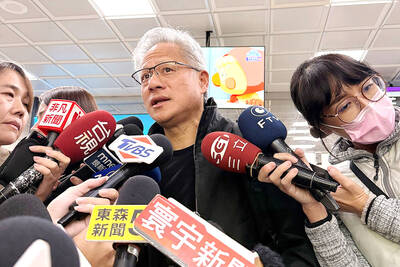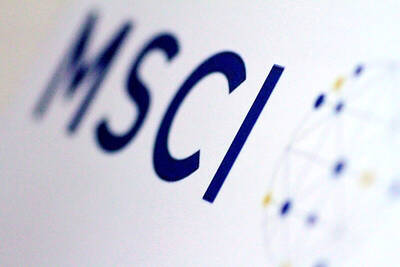Several major think tanks in Taiwan are expected to revise down their forecast for annual GDP growth this week, following Academia Sinica’s cut of its growth forecast for this year to 1.94 percent on Wednesday last week.
The weaker-than-expected economic momentum in the second quarter, caused by continuous global economic uncertainties, would be the major factor dragging down these institutes’ latest forecast, economists said.
“It is difficult for the nation’s economy to grow more than 3 percent this year,” director of the Chung-Hua Institution for Economic Research’s (CIER, 中華經濟研究院) center for economic forecasting Liu Meng-chun (劉孟俊) said by telephone.
Liu cited weak overseas and domestic demand as exports fell 4.7 percent from a year ago in the first six months of the year, with private consumption slower in the same period due to the government’s decision to raise energy prices.
Liu’s views confirmed that the CIER — which is scheduled to update its full-year economic growth forecast today — will cut the figure from the 3.55 percent growth it estimated in April.
The Taiwan Institute of Economic Research (TIER, 台灣經濟研究院), which is set to release its latest growth forecast tomorrow, may also follow the trend, as the think tank estimated in April that economic expansion would reach 3.48 percent this year.
“Taiwan’s economic growth in the second quarter may be lower than that in the first quarter as a result of the impact of slowing domestic demand,” director of TIER’s macroeconomic forecasting center Gordon Sun (孫明德) said.
Many economists had previously thought Taiwan’s economy would bottom out in the first quarter, but it turned out that GDP in the second quarter may show a contraction because of the deteriorating domestic demand, Sun said.
Renewed worries about the nation’s economic prospects have placed speculation and discussion about the central bank possibly cutting interest rates back on the table.
The central bank on June 21 decided to keep its key interest rates unchanged for the fourth consecutive quarter and left its discount rate at 1.875 percent. The bank is expected to review its monetary policy adjustment at a board meeting in late September.
“Taiwan’s policy rate outlook is less than clear at this juncture,” Grace Ng (吳向紅), a Hong Kong-based economist at JPMorgan Chase Bank, said in a report issued on Wednesday last week.
Three months ago, there was a lot of discussion about the need for the central bank to raise policy rates, given the impact electricity and fuel price hikes had on inflation and on driving up uncertainty over the policy rate outlook, Ng said.
JPMorgan said it now views Taiwan’s near-term policy rate outlook as a close call.
“[Only] in the event that the external environment worsens further, will the probability of moderate rate cuts by the central bank rise in the coming months,” Ng said.
On the exchange rate front, it seems that policymakers have been keen to maintain a competitive currency through the economic cycles in support of the export sector, she added.
Cheng Cheng-mount (鄭貞茂), chief economist at Citigroup in Taipei, shared Ng’s views.
“The central bank still has many other tools and open-market operations, such as cutting the overnight interbank call-loan rate, to deal with the current economic situation in Taiwan,” Cheng said by telephone.
Cheng said that he sees no need for the central bank to cut the nation’s policy rates further in the second half of this year given the current low level of rates.
Nonetheless, the central bank has been gradually driving down the overnight interbank call-loan rate since last week, with the rate falling 0.014 percentage points to 0.391 percent on Friday last week, marking the lowest level in nearly 11 months. In the past seven trading sessions, the rate has declined by 0.118 percentage points.
A lower overnight interbank call-loan rate will drag down short-term financing costs for banks, which may further lower domestic firms’ financing costs and raise the market’s liquidity.
Australia and New Zealand Banking Group Ltd said in a report on Friday that the central bank will continue to lower the interbank overnight rates in a bid to reduce banks’ borrowing costs.

PERSISTENT RUMORS: Nvidia’s CEO said the firm is not in talks to sell AI chips to China, but he would welcome a change in US policy barring the activity Nvidia Corp CEO Jensen Huang (黃仁勳) said his company is not in discussions to sell its Blackwell artificial intelligence (AI) chips to Chinese firms, waving off speculation it is trying to engineer a return to the world’s largest semiconductor market. Huang, who arrived in Taiwan yesterday ahead of meetings with longtime partner Taiwan Semiconductor Manufacturing Co (TSMC, 台積電), took the opportunity to clarify recent comments about the US-China AI race. The Nvidia head caused a stir in an interview this week with the Financial Times, in which he was quoted as saying “China will win” the AI race. Huang yesterday said

Japanese technology giant Softbank Group Corp said Tuesday it has sold its stake in Nvidia Corp, raising US$5.8 billion to pour into other investments. It also reported its profit nearly tripled in the first half of this fiscal year from a year earlier. Tokyo-based Softbank said it sold the stake in Silicon Vally-based Nvidia last month, a move that reflects its shift in focus to OpenAI, owner of the artificial intelligence (AI) chatbot ChatGPT. Softbank reported its profit in the April-to-September period soared to about 2.5 trillion yen (about US$13 billion). Its sales for the six month period rose 7.7 percent year-on-year

MORE WEIGHT: The national weighting was raised in one index while holding steady in two others, while several companies rose or fell in prominence MSCI Inc, a global index provider, has raised Taiwan’s weighting in one of its major indices and left the country’s weighting unchanged in two other indices after a regular index review. In a statement released on Thursday, MSCI said it has upgraded Taiwan’s weighting in the MSCI All-Country World Index by 0.02 percentage points to 2.25 percent, while maintaining the weighting in the MSCI Emerging Markets Index, the most closely watched by foreign institutional investors, at 20.46 percent. Additionally, the index provider has left Taiwan’s weighting in the MSCI All-Country Asia ex-Japan Index unchanged at 23.15 percent. The latest index adjustments are to

CRESTING WAVE: Companies are still buying in, but the shivers in the market could be the first signs that the AI wave has peaked and the collapse is upon the world Taiwan Semiconductor Manufacturing Co (TSMC, 台積電) yesterday reported a new monthly record of NT$367.47 billion (US$11.85 billion) in consolidated sales for last month thanks to global demand for artificial intelligence (AI) applications. Last month’s figure represented 16.9 percent annual growth, the slowest pace since February last year. On a monthly basis, sales rose 11 percent. Cumulative sales in the first 10 months of the year grew 33.8 percent year-on-year to NT$3.13 trillion, a record for the same period in the company’s history. However, the slowing growth in monthly sales last month highlights uncertainty over the sustainability of the AI boom even as